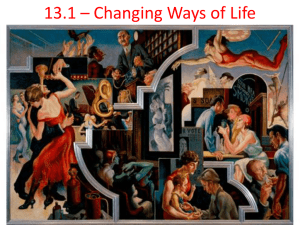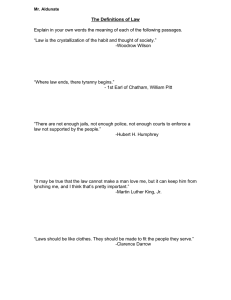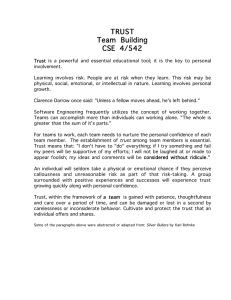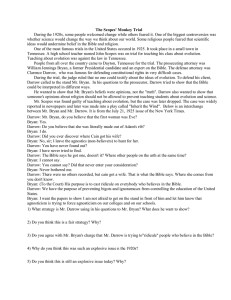1920’s HOH
advertisement
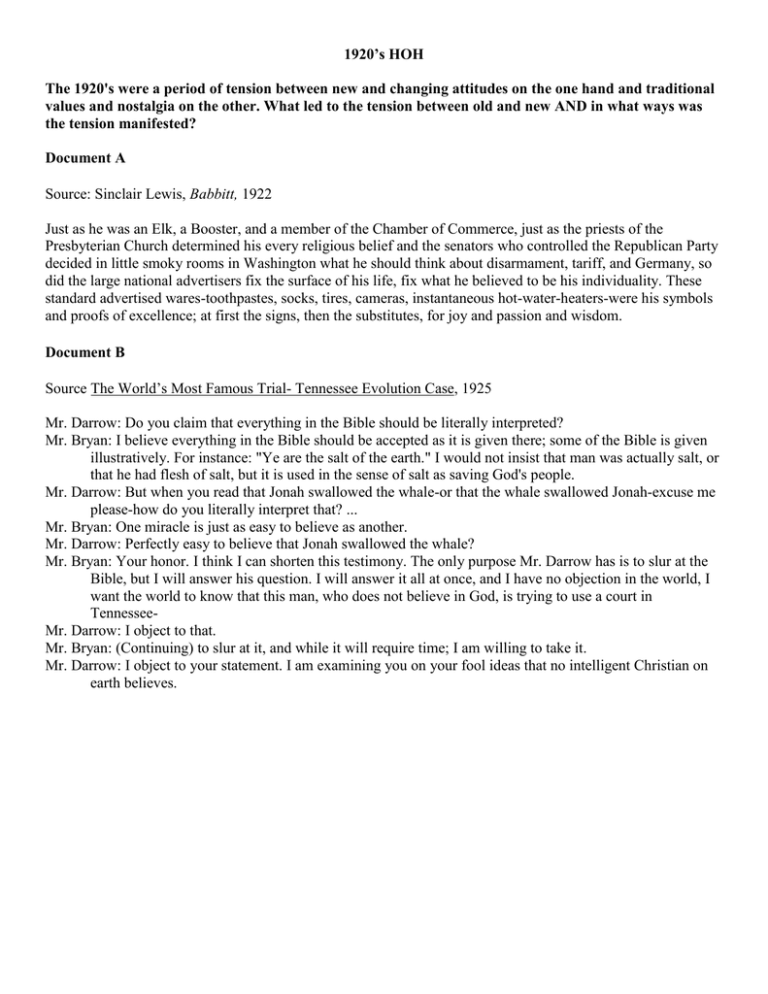
1920’s HOH The 1920's were a period of tension between new and changing attitudes on the one hand and traditional values and nostalgia on the other. What led to the tension between old and new AND in what ways was the tension manifested? Document A Source: Sinclair Lewis, Babbitt, 1922 Just as he was an Elk, a Booster, and a member of the Chamber of Commerce, just as the priests of the Presbyterian Church determined his every religious belief and the senators who controlled the Republican Party decided in little smoky rooms in Washington what he should think about disarmament, tariff, and Germany, so did the large national advertisers fix the surface of his life, fix what he believed to be his individuality. These standard advertised wares-toothpastes, socks, tires, cameras, instantaneous hot-water-heaters-were his symbols and proofs of excellence; at first the signs, then the substitutes, for joy and passion and wisdom. Document B Source The World’s Most Famous Trial- Tennessee Evolution Case, 1925 Mr. Darrow: Do you claim that everything in the Bible should be literally interpreted? Mr. Bryan: I believe everything in the Bible should be accepted as it is given there; some of the Bible is given illustratively. For instance: "Ye are the salt of the earth." I would not insist that man was actually salt, or that he had flesh of salt, but it is used in the sense of salt as saving God's people. Mr. Darrow: But when you read that Jonah swallowed the whale-or that the whale swallowed Jonah-excuse me please-how do you literally interpret that? ... Mr. Bryan: One miracle is just as easy to believe as another. Mr. Darrow: Perfectly easy to believe that Jonah swallowed the whale? Mr. Bryan: Your honor. I think I can shorten this testimony. The only purpose Mr. Darrow has is to slur at the Bible, but I will answer his question. I will answer it all at once, and I have no objection in the world, I want the world to know that this man, who does not believe in God, is trying to use a court in TennesseeMr. Darrow: I object to that. Mr. Bryan: (Continuing) to slur at it, and while it will require time; I am willing to take it. Mr. Darrow: I object to your statement. I am examining you on your fool ideas that no intelligent Christian on earth believes. Document C “The Bridge” by Joseph Stella, 1922. Collection of the Newark Museum Document D Source: Hiram Wesley Evans, "The Klan's Fight for Americanism," The North American Review, March 1926 We are a movement of the plain people, very weak in the matter of culture, intellectual support, and trained leadership. We are demanding, and we expect to win, a return of power into the hands of the everyday, not highly cultured, not overly intellectualized, but entirely unspoiled and not de-Americanized, average citizen of the old stock. Our members and leaders are all of this class-the opposition of the intellectuals and liberals who held the leadership, betrayed Americanism, and from whom we expect to wrest control, is almost automatic. This is undoubtedly a weakness. It lays us open to the charge of being "hicks" and "rubes" and "drivers of second-hand Fords." We admit it. Far worse, it makes it hard for us to state our case and advocate our crusade in the most effective way, for most of us lack skill in language. The Klan, therefore, has now come to speak for the great mass of Americans of the old pioneer stock. We believe that it does fairly and faithfully represent them, and our proof lies in their support. To understand the Klan, then, it is necessary to understand the character and present mind of the mass of old-stock Americans. The mass, it must be remembered, as distinguished from the intellectually mongrelized "Liberals." These are, in the first place, a blend of various peoples of the so-called Nordic race, the race which, with all its faults, has given the world almost the whole of modern civilization. The Klan does not try to represent any people but these. Document E Source: Langston Hughes, The Negro Artist and the Racial Mountain The Nation, 1926. Jazz to me is one of the inherent expressions of Negro life in America: the eternal tom-tom beating in the Negro soul-the tom-tom of revolt against weariness in a white world, a world of subway trains, and work, work, work; the tom-tom of joy and laughter, and pain swallowed in a smile. Yet the Philadelphia clubwoman ... turns up her nose at jazz and all its manifestations-likewise almost anything else distinctly racial .... She wants the artist to flatter her, to make the white world believe that all Negroes are as smug and as near white in soul as she wants to be. But, to my mind, it is the duty of the younger Negro artist ... to change through the force of his art that old whispering "I want to be white," hidden in the aspirations of his people, to "Why should I want to be white? I am Negro-and beautiful." Document F Source: Mary B. Mullett, The Biggest Thing That Lindbergh Has Done, The American Magazine, October, 1927 When, because of what we believe him to be, we gave Lindbergh the greatest ovation in history, we convicted ourselves of having told a lie about ourselves. For we proved that the "things of good report" are the same today as they were nineteen hundred years ago. We shouted ourselves hoarse. Not because a man had flown across the Atlantic! Not even because he was an American! But because he was as clean in character as he was strong and fine in body; because he put "ethics" above any desire for wealth; because he was as modest as he was courageous; and because-as we now know, beyond any shadow of doubt-these are the things which we honor most in life. To have shown us this truth about ourselves is the biggest thing that Lindbergh has done. Document G Source: Women Smokers, The New York Times, February 29, 1928. Be it resolved, that the National W.C.T.U. [Women's Christian Temperance Union] encourages further scientific research into the effects of nicotine and urges all public and private school teachers and Sunday school workers, both by precept and example, to assist in an educational campaign to make these effects known with a view to instructing the youth as to the well-proven facts of science; and Be it further resolved, that the National W.C.T.U. brands as untrue the charge made by the Association Opposed to National Prohibition that we are engaged in a secret campaign for an amendment to the Constitution prohibiting tobacco.... [Mrs. Ella A. Boole, President of the New York State organization says:] "We are working on this question from a scientific standpoint and from an educational standpoint. After all, the duty of motherhood is still relegated to the women of the nation. Just as long as, that is true we must protect the coming generation by teaching the present one the effects of the habit of smoking on the unborn ...... Document H Document I Source: Boston Globe, Boston Police Strike Document I Source: Morrow Mayo, "Aimee Rises from the Sea," The New Republic, December 25, 1929. “.… Sister substituted the Gospel of Love for the Gospel of Fear. This doctrine was as strange in Southern California as it is elsewhere in Christendom.... Sister substituted the cheerfulness of the play-room for the gloom of the morgue. She threw out the dirges and threats of Hell, replacing them with jazz hymns and promises of Glory. The Gospel she created was and is an ideal bed-time story. It has a pretty color, a sweet taste, and is easy. Mrs. McPherson describes the Holy City literally-the jewelled walls, pearly gates, golden streets, milk and honey. She says she is not sure-she is not sure, mind you-but she has a pretty good idea that Heaven will resemble a cross between Pasadena, California, and Washington, D.C. That will give an idea of what may be expected at Angelus Temple. The atmosphere bubbles over with joy, enthusiasm; the Temple is full of flowers, music, golden trumpets, red robes, incense nonsense and sex appeal. The service may be described as supernatural whoopee.”

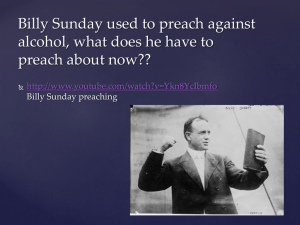
![Changes%20in%20American%20Society[1] - pams](http://s3.studylib.net/store/data/009097112_1-9a8e74b6b539401fd3776a36445a3f2f-300x300.png)
